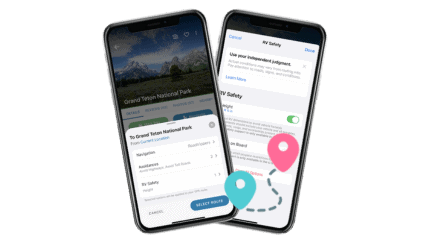RVs are long, wide, and difficult to maneuver. But, don’t forget—RVs are tall, too. This means when it comes to overhangs, bridges, canopies, and power lines, you have to be careful; RVs and low clearances don’t play well together.
We also recently launched an AI trip planner that’ll help you build an RV-friendly itinerary by learning about your rig and planning the best trip for your specific needs. Try Autopilot™ today.
How tall is your RV?
Not how tall does the owner’s manual say it is, but how tall is it really?
Did you add an air conditioning unit? Is anything else up there? Maybe an additional storage unit? Some solar panels? All of this needs to be taken into consideration when determining the true height of your RV. Really, you have to go out and measure it yourself. This way, you know for sure, which helps you better plan your traveling route without worrying about losing your satellite dish under a lower-than-expected bridge.
6 steps to planning a successful RV road trip
Height clearances
While the Federal Highway Administration sets bridge clearances between 14 and 16 feet, sometimes special design exceptions allow for a bridge to be lower. Also, many local and state bridges don’t have to abide by federal regulations. This is particularly true the further you go into more rural areas.

Something else to keep in mind is that just because a bridge is listed as giving 14 feet of clearance, that doesn’t mean the roadway under that bridge hasn’t been repaved. The practice of grinding off old asphalt before putting new asphalt down is relatively new. The roadway under a bridge could have been repaved numerous times, with the average change in height on the road being 2 inches per re-pavement—that adds up.
While bridges will at least have warning signs telling you of their height and clearance, the same cannot always be said of power lines, big tree branches, and the canopies you’ll find at gas stations, fast food restaurants, and ATMs. Be sure to keep an eye out for these types of obstacles as well.
How to avoid driving obstacles
Here are some tips for avoiding these obstacles when planning your RV route:
- Know the real height of your RV and put it on a sticky note by your captain’s chair.
- When driving under a bridge that you suspect to be close to the top of your RV, drive very slowly. By going slowly, you can help avoid any unexpected bounces from the road’s uneven surface.
- Avoid routes where trucks are prohibited. They’re probably not allowed because of height and weight restrictions that can restrict you as an RV driver as well.
- Play it safe and subtract 6 inches from any bridge clearance warning sign. If it says 14 feet, assume it’s 13 feet, 6 inches.
- Be extra careful when traveling on private property since these locations aren’t subject to federal regulations about clearance height.
- At service stations, have your co-pilot get out and visually report whether it looks like your RV will fit under the canopy.
Finally, if you hear a scrape, stop immediately. Don’t try and force the issue, and don’t expect lowering the air in your tires will solve the problem. Back up if it’s safe to do so, and find a different route.
You should also consider an RV roadside assistance plan and carry emergency equipment in your RV, just in case. Things like road flares and neon cones can be used to warn other drivers if you find yourself stuck.
Use RV-friendly trip routing
Use an app that offers RV-friendly driving directions. Our Autopilot AI trip planner has features that help you map out routes based on your RV’s height, propane restrictions, and more—so you can find the safest roads for all of your extraordinary RV adventures.
There are also RV GPS units from brands like Garmin, TomTom, Magellan, and Rand McNally (prices range from around $200 to $400). RV-specific GPS models and smartphone apps are helpful, but they aren’t 100 percent dependable. You still have to stay sharp and keep an eye out. As for the Motor Carriers’ Road Atlas (the trucker’s bible), RV drivers aren’t truckers. Truckers tend to stick to the highways and interstates to get their job done. RV drivers tend to be interested in driving along more remote scenic byways, where road information is a little less reliable.
You can’t just rely on these tools to get to your destination—you’ll still need to plan and take an active role in finding the right route to where you’re going. As a driver of an RV, you take on certain responsibilities. Be aware, drive slowly, take it easy, and keep looking up.










